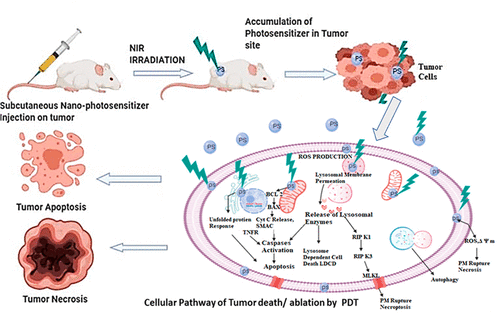当前位置:
X-MOL 学术
›
ACS Biomater. Sci. Eng.
›
论文详情
Our official English website, www.x-mol.net, welcomes your feedback! (Note: you will need to create a separate account there.)
Photodynamic Nanophotosensitizers: Promising Materials for Tumor Theranostics
ACS Biomaterials Science & Engineering ( IF 5.8 ) Pub Date : 2020-09-14 , DOI: 10.1021/acsbiomaterials.0c01058 Rajendiran Keerthiga 1 , Zizhen Zhao 1 , Desheng Pei 2 , Ailing Fu 1
ACS Biomaterials Science & Engineering ( IF 5.8 ) Pub Date : 2020-09-14 , DOI: 10.1021/acsbiomaterials.0c01058 Rajendiran Keerthiga 1 , Zizhen Zhao 1 , Desheng Pei 2 , Ailing Fu 1
Affiliation

|
Photodynamic theranostics/therapy (PDT) is a potential strategy for selectively imaging malignant sites and treating cancer via a non-invasive therapeutic method. Photosensitizers, the crucial components of PDT, enable colocalization of photons and light, and photon/light therapy in the therapeutic window of 400–900 nm exhibits photocytotoxicity to tumor cells. Due to their high biostability and photocytotoxicity, nanophotosensitizers (NPSs) are of much interest for malignant tumor theranostics at present. NPS-activated photons transfer energy through the absorption of a photon and convert molecular oxygen to the singlet reactive oxygen species, which leads to apoptosis and necrosis. Moreover, NPSs modified by polymers, including PLGA, PEG-PLA, PDLLA, PVCL-g-PLA, and P(VCL-co-VIM)-g-PLA, exhibit excellent biocompatibility, and a tumor-targeting molecule linked on the nanoparticle surface can precisely deliver NPSs into the tumor region. The development of NPSs will accelerate the progress in tumor theranostics through the photon/light pathway.
中文翻译:

光动力纳米光敏剂:肿瘤治疗学的有前途的材料
光动力疗法/疗法(PDT)是一种潜在的策略,可通过无创治疗方法选择性地对恶性部位成像并治疗癌症。光敏剂是PDT的关键成分,能够使光子和光共定位,并且在400-900 nm的治疗范围内进行光子/光疗法对肿瘤细胞具有光细胞毒性。由于其高的生物稳定性和光细胞毒性,目前,纳米光敏剂(NPS)对于恶性肿瘤治疗学而言非常受关注。NPS活化的光子通过吸收光子来转移能量,并将分子氧转化为单线态活性氧,从而导致细胞凋亡和坏死。此外,被聚合物改性的NPS,包括PLGA,PEG-PLA,PDLLA,PVCL- g -PLA和P(VCL- co -VIM)-g- PLA具有出色的生物相容性,并且连接在纳米颗粒表面的靶向肿瘤的分子可以将NPS精确地递送至肿瘤区域。NPS的发展将通过光子/光途径加速肿瘤治疗学的进展。
更新日期:2020-10-12
中文翻译:

光动力纳米光敏剂:肿瘤治疗学的有前途的材料
光动力疗法/疗法(PDT)是一种潜在的策略,可通过无创治疗方法选择性地对恶性部位成像并治疗癌症。光敏剂是PDT的关键成分,能够使光子和光共定位,并且在400-900 nm的治疗范围内进行光子/光疗法对肿瘤细胞具有光细胞毒性。由于其高的生物稳定性和光细胞毒性,目前,纳米光敏剂(NPS)对于恶性肿瘤治疗学而言非常受关注。NPS活化的光子通过吸收光子来转移能量,并将分子氧转化为单线态活性氧,从而导致细胞凋亡和坏死。此外,被聚合物改性的NPS,包括PLGA,PEG-PLA,PDLLA,PVCL- g -PLA和P(VCL- co -VIM)-g- PLA具有出色的生物相容性,并且连接在纳米颗粒表面的靶向肿瘤的分子可以将NPS精确地递送至肿瘤区域。NPS的发展将通过光子/光途径加速肿瘤治疗学的进展。

























 京公网安备 11010802027423号
京公网安备 11010802027423号